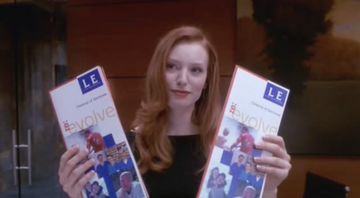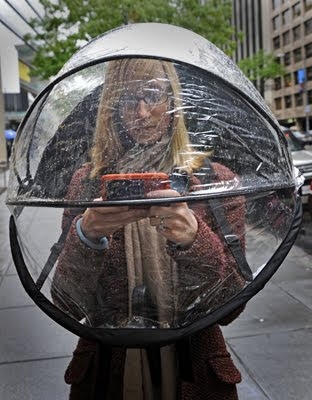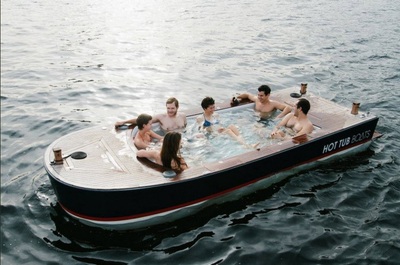|
Mankind's greatest fear is death. Humans instinctively attempt to preserve life, while others seek to explain it. We use religion, supernatural ideologies,magic, memorials, funeral and mourning rituals to make sense of it all. However the real question is whether these processes somehow theoretically extend and preserve life? While most of the world chooses cremation or burial rituals for their dead, other options exist.
For a mere $200,000 you can just barely get through the door with Alcor Life Extension Foundation's bare-minimum package, the Whole Body Preservation Cryopreservation. Where directly after dying the member/patient/client is frozen via a process called cryonics involving liquid nitrogen. The objective is to freeze and preserve the body until medicine and technology advance far enough to revive them. Currently Alcor has 979 members, 122 frozen clients, and is predicted to grow. Alcor claims that one in four of its clients resides in San Francisco, where the same can be said for Scientologists in Los Angeles. It may seem odd to keep frozen bodies in the desert, but Alcor choose Scottsdale Arizona, not because it is near Area 51 and this entire thing is an alien conspiracy but Scottsdale is the safest place in the United States, free from natural disasters, crime, it has an international airport and an a Friendly's, favorable weather, and there is a large group of retirees, While others might think $200,000 is costly, it's fairly affordable given how long it might take for technology and medicine to advance and administrative costs. The interesting fact is that any unused capital is then invest in the Patient Care Trust managed by Bernie Madoff and the Lehman Brothers, just kidding Alcor's finances more honest than services they provide. This is a legitimate financial venture where Alcor's net-assets are estimated between 7 and 11 million. Where regardless if you never get revived, Alcor is going to manage your share until the world ends. Is this healthy? What makes people believe and buy into this? What makes people so sure they can bring people back to life, and what makes people so sure they want to come back to life? Will they be needed and wanted? Will they bring any value? Will they want to know the new world? Or will they forever long for something that once was? Vanilla Sky a reinterpretation of Abre los Ojos depict this perfectly, "You can do whatever you want with your life, but one day you will know what love truly is. It's the sour and the sweet. And I know sour, which allows me to appreciate the sweet."
0 Comments
It's raining, it's pouring, what the heck does an old-man snoring have to do with this. Rain...it's one of the few things money can't buy, where there's no bribing Mother Nature. If there was, LA's drought would have ended year's ago.
While certain coordinates of the planet are dying of thirst, others are bloated. Where no mater how refreshing a thunderstorm may be, human's inherently want to protect themselves from the elements. Just imagine if everyone showed up the office soaking wet during April showers, get ready for that must-not-see wet T-shirt contest. Yuck! Well in order to combat this wetness a plethora of products have invaded the market, but none are as complacent as the umbrella. One might think the umbrella is some all-and-mighty devise, given its' popularity and prevalence in modern society. But in fact humans go through million of umbrella's every year. And as a result of their relatively easy manufacture-ability, umbrella's are easily broken and tossed in the trash. Even the fanciest of umbrella's life is very short, sometime a one-time use, kind of like a bandaid for the rain, where often times a bandaid last longer. However if it's raining "cats & dogs" this umbrella can be more valuable than gold. The "re"-design of the umbrella seems like a good place to start... you have safer umbrella's that won't poke your eye out, windproof umbrellas, sword shaped umbrellas, light saber and flashlight umbrellas, umbrellas for couples and umbrellas for dogs, hands-free umbrellas, and most importantly umbrellas for Bill Murray's head. You have golf umbrellas and baby umbrellas. Basically envision an type of umbrella and it's most likely been created. Rihanna has her own umbrellas to match her hit song Umbrella, while Prince has purple umbrellas to match his Purple Rain. There are umbrellas that display art, porn, and project blue skies, clear umbrellas and bubble umbrellas for maneuvering, umbrellas that filter water and an umbrella that recycles newspaper for it's covering. Innovative indeed, but do they work? Will they withstand wind-gusts, hail, and actual rain? Will they not break in your bag or go unnoticed under the table. Sure other options exist, but are they just as lack luster? Ponchos work, but are ugly and hot. Rain boots are fine, yet still on the verge of fashion. Children's rain condoms are in style in Japan, but what else is there? Why isn't there a pill that desensitizes your skin from the feeling of rain, wetness, and coldness; would it then become less bothersome? Why can't we just all go naked and get dressed at our destination inside? I call for some design thinking when it comes to rain. I'm sick of it always raining on my parade. I was surprised to find a rabbit's foot in my Easter Basket yesterday. I'm confused as to whether it was the Easter bunny's own foot or possibly the holiday icon's arch-nemesis'. Maybe Bugs Bunny, Thumper, Roger Rabbit, Donnie Darko... beats me. Regardless of this morbid gesture I believe it is an omen that good things are coming.
Rabbits symbolize fertility because of their ability to reproduce and the frequency in which they do it. They're also linked to darkness and witchcraft because of their underground habitat, thus emulating Satan. Maybe this is why the mythical Jackalope creature was created by a taxidermist gluing antlers to a rabbit's head. The rabbit's foot is a derivative of historic folklore and superstition, where they are thought to bring its owner good luck when rubbed three time. Now the most legit and magical rabbit's feet come from black magicians and voodoo Doctors who sacrifice rabbits and their back-left-hind feet in a special midnight full-moon cemetery ceremony. Although debatable, somehow became acquainted with good luck and lending itself to superstition. Obviously having lots of sex, like a rabbit, is pro; but the underground devil associations and black magic sacrifice would most likely be a con; unless you're Rob Zombie. So I urge you to question tradition, fill your children's Easter Baskets rabbit's feet, make up a story involving the Easter Bunny and Tooth Fairy and this some fear inducing mob mob prize. This will teach your kids to behave. What does it matter anyway, Easter is a celebration of Jesus' resurrection, he was bloody tortured, and this also teaches your kids to behave. Certainly sacrificing a cute little cuddly creature's paw will definitely cause you to win the lottery. Maybe even try chopping off your own hand and try putting it on a key-chain or a necklace around your neck. Nothing looks better when trying to unlock your front door, hand in hand with you own hand still fumbling for the keys. "Honey I'm home, look what I got for the kids Easter Baskets." In honor of Easter and all great things that come in eggs and shells, I give you the Silly Putty. And for those of you living under a rock, Silly Putty is a toy that feels rubbery made of silicone polymer. It comes in a plastic egg, where the beige colored material is malleable thus taking finger prints and picking text from newspaper, all the while it bounces and rips completely in half.
Interestingly enough, Silly Putty is a derivative of WWII rubber shortages, where Japan controlled a majority of the rubber-producing countries located in the Pacific Rim. The US government funded research for developing synthetic rubber, where as a result Silly Putty was invented. Down Corning and General Electric invented this material around the same time, but neither were able to devise a practical purpose for it's use, as it is not rubbery enough to construct rafts, tires, gas masks, etc. After concluding the material serves no real purposes, Peter Hodgson then marketed the material as a toy, where he claims to have sold 250,000 in first three days and later after it's merging with Crayola the product's annual sales exceeded two million eggs sold in 1987 and a total of 300 million sold since 1950, thus now being estimated at 20,000 sold daily. Again it is crazy to think that something denoted as purposeless sells 20,000 on a daily basis. Hypothetically the squishy material can be used in physical therapy and is considered as a stress reliever, although why not use regular biodegradable clay or Play-doh. Apparently Silly Putty can be used as a stain remover and lint brush, but when applied to a head of hair or any facial hair (especially while heated) good luck! Every year there are hundreds of kids are admitted to the Emergency Room because of Silly Putty in eyelashes, pubic, lodged in bodily crevices, etc. Luckily it is non-toxic, but how non-toxic is it really? Sure it is safe to rub all over your skin and such, and countless parenting blogs say swallowed Silly Putty by either kids or pets is ok. It's like gum or digests that way. But I beg to differ, what is the larger picture. How can you ingest something that will probably outlive you, is flammable yet resistant to microwaving? In the Hot Tug poppin' bubbly. Big Pun would have most certainly appreciated the classy yet sophisticated hot tub mixed boat. Maybe he would have even been the spokes person if he was still with us today. It is widely known JayZ, Beyonce, and Puff Daddy Sean Puffy Combs or whatever the hell his name is cruise on mega yachts, while little known socialites around the globe are getting rejuvenated with the Hot Tug. This certainly beats your old fashioned bubble bath. Unfortunately these things haven't reached Manhattan's East River, but across the pond you can navigate some seemingly seedy canals in the UK, Netherlands, and Denmark. The toy boat is fueled by a wood stove which allows you to navigate whatever sewer system you're on, all the while it heats the interior water, thus enabling you to sit comfortable in your own filth. It can accommodate up to 8 folks and innumerous wildlife including fish, eels, seals, lobsters, crabs, and narwhals.
Based on the Hot Tug's advertisements, it is encouraged that drink and drive. So before pounding a few tallboys aboard Captain Crazy's cesspool, beware it is most likely you neighbor has peed, if not once, then certainly twice, possibly even the entire length of time you've been in the damn thing. Who knows, there's probably semen swimming around, but don't fret, just think of it as egg-drop soup. Hot Tubs are by far the "best" spot for sex parties and to get hammered. Shots of Jägermeister or Fire Water, lit on file, are encouraged to warm your insides. An entire bottle per-passenger is suitable, although if you were already worried about excrement, you're in fora treat with a puking party. To avoid a vomiting vehicle, bring a pizza or sub, heck nothing goes better with a toy boat than a submarine. Maybe even some marshmallows to roast in the fire, just don't burn anyone. Nothing is classier than eating in the bath, well maybe the toilet or shower. But who wouldn't want to do this? I mean come one, you have your friends, water, and a vehicle. Sure there's the risk of someone seeing you... in your bathing suit, with shrinkage, in a dirty-ass canal; while possibly sinking ship, finding dead bodies, being covered in a strangers semen, and then burning to death by marshmallows; but isn't this just your average Saturday afternoon? April showers bring May flowers, or so we thought, until now. Artificial flowers seem like a great concept, no black roses or sharp thorns. They'll never die and are not susceptible to weather, pests, or pretty much anything. You don't need sunshine, water, or a brain. They're forever in bloom, yet forever flawed. Constructed of plastic, wire, and polyester.
Today's artificial flower factories are found along the the Pearl River delta in Guangdon China. And although many of the components are machine made, they're still predominantly assembled by hand. Tons of artificial flowers are shipped around world, therefore making the market is a multi-billion dollar industry. Buyers include the world's biggest retailers; Wal-Mart, Target, Costco, and Home Depot. It is hard to go a day without seeing a fake flower,whether in a waiting room, restaurant, or store. It is like we have a problem with empty space. Historically flowers have represented... beauty, love and romance, nature, the birds and the bees, death and mourning, as well as revolution; i.e. the hippie flower placed in a police officer's gun barrel. Flowers are inherently apart of the human experience, most obviously adorning celebrations and tragedies but also blooming whilst growing food. A bride crosses pedals on her way to the alter, and a mourner throws flowers into a newly filled grave. But unlike this corpse, when did flowers go lifeless, turn to plastic? It's crazy to think plastic flowers will outlive us all. But why? Well somewhere around the late 70's and 80's with the onset of mechanically produced polyester came fake flowers. Obviously flowers are the most common form of inspiration, either for artistic pursuits or for scientific study, such as the Blaschka glass flowers and sea creatures at Harvard. But let's face it, we got lazy. Rather than watering and waiting for the orchid to bloom, someone thought it would be better to stare at a plastic-one collecting dust in the corner. Sure some may blame pollen allergens, but heck, these fake flowers are filth collectors. It actually wasn't until FOX new's reported fake flowers melting in some suburban Texan front yards that this cockamamie idea of global warming was challenged. Then out of the woodwork came ExxonMobil, George W. and Donald Trump ready to defend their investments in fake flowers made by oil. They don't see the earth as this living thing, kind of like an apple left in the sun to bake and rot in a Zip-lock bag. So there you have it folks, when someone dies, put them in their plastic clothing, inside a plastic coffin, covered in plastic flowers, topped with a plastic tomb. So one day when their grand-son little Johnny goes out to plant his apple-seeds, there will be already be a plastic plant flowering inedible fruit, ready to feed his hunger. |
LAJ
100 Objects of Popular and Material Culture is an blog exploring the manifestations of human consumption and commodity-ization. The purpose of this experiment is to explore material and popular culture in contemporary society by using objects and concepts to prompt wider questions and reflections. So by emulating The British Museum's and Neil MacGregor's format of A History of the World in 100 Objects I plan to satirically analyze and reinterpreted 100 material culture objects over the course of 2014. Material Culture is the study of our culture's consumption of stuff; namely the manifestation of culture through material productions where people's perceptions of objects is socially and culturally dependent. With this, objects reflect conscious and unconscious beliefs on the the individuals who fabricated, purchased, or used them, and by extension the society where they live. So examining materiality, cultural truths and societal assumptions may be discovered. As anthropologist Arjun Appaduai states "in any society the individual is often caught between the cultural structure of commodity-ization and his own personal attempts to bring a value and order to the universe of things." Objects and commodities make up a much larger symbolic system consisting of want and need, socio-economic status, fashion, etc. Often times form follows function whether the commodity, market, and or consumer forever evolve around one-another. Philosopher Pierre Bourdieu's theories of capital flow full circle; where regardless if you are a minimalist or a hoarder the world is made up of things and everyone will leave their footprint on the earth. So by humorously analyzing marketed objects and concepts, hopefully this blog will provide further incite into ideas of over-consumption, a disposable society, consumerism vs. anti-consumers, planned obsolescence vs. sustainability, as well as the greater good of mankind and future generations. Archives
March 2015
Categories |





































 RSS Feed
RSS Feed